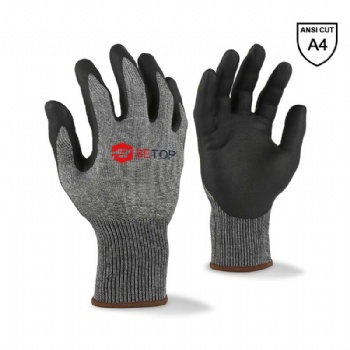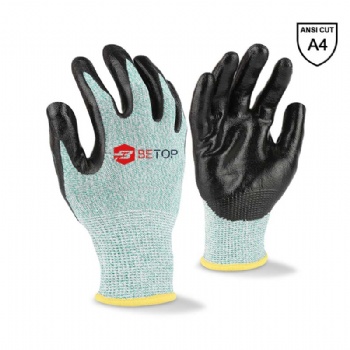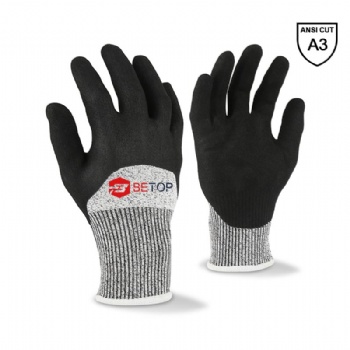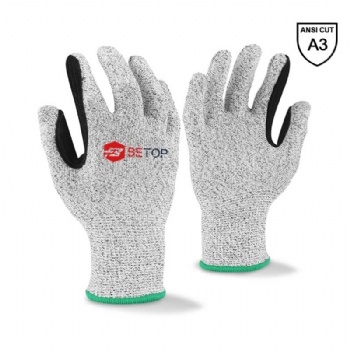I. Uses
1. Kitchen Operations
(1) Professional Kitchens and Abattoirs
In professional kitchens and abattoirs, where knife operations are frequent and the knives are extremely sharp, the A9 highest - cut - resistance grade metal mesh cut - resistant gloves are indispensable for safety. For butchers, when performing large - scale meat - cutting operations, such as breaking down whole cows or pigs into different parts, large and sharp knives are required. During the rapid wielding and cutting of these knives, even a slight carelessness can cause serious hand injuries. This glove can provide butchers with all - round protection. Whether the blade slides horizontally or cuts vertically, its high - strength metal mesh can effectively resist the intrusion of the blade and prevent cuts.
When chefs process food ingredients, especially when performing delicate deboning operations, such as handling the bones of chickens, ducks, fish, etc., they need to use small but sharp knives. During the deboning process, hands need to be in close contact with the blade, and a slight deviation may lead to cuts. This glove allows chefs to operate with confidence, avoiding work - efficiency losses due to hand injuries while ensuring hygiene and safety in food processing.
(2) Seafood Processing
In the field of seafood processing, workers often have to deal with spiny fish, such as perch and mandarin fish. The fish bones of these fish are not only sharp but also come in various shapes, and it is easy to stab hands during the processes of scaling, gutting, and deboning. In addition, when handling shellfish such as oysters and scallops, the edges of the shells are sharp and can easily cut fingers. The metal mesh structure of the A9 gloves can easily resist the injuries caused by these sharp objects, ensuring the hand safety of seafood processing workers and enabling them to complete their work more efficiently.
2. Industrial Applications
(1) Glass Manufacturing and Processing Industry
In the glass manufacturing process, from the initial cutting of glass sheets to the later glass - forming processing, workers need to use various cutting tools, such as glass cutters and diamond - tipped tools. When these tools cut glass, a large number of sharp glass fragments are generated. Once the glass fragments splash onto hands or when workers pick up the cut glass, it is easy to scratch their hands. The metal mesh of the A9 cut - resistant gloves can effectively block the cuts from glass fragments. Whether they are small fragments or large - sized off - cuts, they cannot penetrate the gloves and harm the workers.
(2) Metal Processing Industry
In the metal processing industry, in operations such as sheet - metal cutting, high - speed cutting equipment, such as laser cutters and plasma cutters, are required. The off - cuts of metal sheets after cutting by these equipment are very sharp. Moreover, when handling, bending, and grinding metal sheets, hands are also easily scratched by the sharp edges and corners of the metal. The A9 gloves can provide reliable protection for workers during these high - risk operations, ensuring the hand safety of workers in the metal - processing process.
II. Materials
1. Metal Mesh Material
(1) High Strength and Toughness
The metal material used for this glove has excellent strength and toughness. The metal wire is an alloy material that has been carefully selected and specially treated. This alloy can withstand huge external forces without breaking. In laboratory tests, even when facing cutting forces of several hundred Newtons, the metal mesh can remain intact, effectively preventing the blade from penetrating. Its toughness enables the metal mesh to disperse stress through its own deformation when subjected to external impact, rather than being prone to brittle fracture like ordinary metals.
(2) Corrosion - Resistant Properties
The metal wire has undergone special anti - corrosion treatment. In the kitchen environment, the gloves may come into contact with food ingredients containing salts and acidic substances (such as vinegar, lemon juice, etc.) and cleaning agents. In the industrial environment, they may come into contact with various chemical substances. The treated metal wire can remain stable in these complex chemical environments and will not rust or lose strength due to corrosion. For example, in the salt - spray test, after long - term salt - spray spraying, there is no significant change in the appearance and performance of the metal mesh, and it can still maintain good cut - resistance performance.
2. Auxiliary Materials
(1) Wrist - Band Fabric Material
The wrist - band part of the glove is made of a highly elastic and highly wear - resistant fabric material. This fabric material is woven from high - strength synthetic fibers and has excellent flexibility. It can closely fit the wrist without causing a sense of restraint due to wrist movements. In terms of comfort, the surface of the fabric has been specially treated, with a soft touch, and will not cause friction or irritation to the skin. Moreover, this fabric material also has good moisture - absorption properties, which can keep the wrist area dry during long - term wearing, improving the wearing comfort.
In terms of durability, the fabric material has undergone multiple stretching and friction tests. The results show that even after thousands of times of stretching and friction, the fabric will not show phenomena such as pilling or breaking, ensuring the stability of the wrist - band part during long - term use of the glove.
III. Manufacturing Process
1. Metal Mesh Weaving
(1) Fine Weaving Pattern
The metal mesh is woven using a highly precise and complex weaving pattern. The metal wires are interwoven at specific angles and sequences to form a honeycomb - like network layout. This weaving method enables each metal wire to evenly share external pressure, thereby maximizing the overall strength of the glove. During the weaving process, the intersection points of the metal wires have undergone special welding or riveting treatments to ensure that each node is firm and reliable. For example, through electron - microscope observation, it can be found that the metal atoms at these nodes have merged with each other, forming a stable connection structure, preventing the metal wires from loosening or slipping during use.
(2) Flexibility Design
While ensuring strength, the weaving of the metal mesh also takes into account the flexibility of the hand. The tightness of the metal wires has been precisely adjusted during weaving, so that the glove can conform to the shape of the hand in a natural state, and when the hand bends or makes a fist, the metal mesh can deform along with the contour of the hand without hindering the movement of the hand. This flexibility is achieved by adjusting the density of the metal wires in different parts. For example, the density of the metal wires at the finger joints is relatively small to ensure that the joints can move freely.
2. Component Assembly
(1) Wrist - Band Installation
The assembly of the wrist - band and the metal mesh is a crucial step in the manufacturing process. The installation position of the wrist - band is designed ergonomically, located at the most comfortable part of the wrist and the position that can ensure the stability of the glove. During the installation process, first, one end of the wrist - band is fixed to the edge of the metal mesh through high - strength stitches. This stitch uses special abrasion - resistant fibers that can withstand repeated stretching and friction. Then, the wrist - band is adjusted around the wrist, and fastened through the adjustment device (such as Velcro or a metal buckle) on the wrist - band. The design of the adjustment device can adapt to people with different wrist thicknesses, ensuring that the glove is neither too tight to affect blood circulation nor too loose to cause the glove to slip off when worn.
(2) Connection - Point Reinforcement
For the connection part between the metal mesh and the wrist - band, in addition to stitch - based fixation, additional reinforcement measures are taken. For example, a layer of high - strength rubber lining is added to the inner side of the connection part. This rubber lining can further enhance the firmness of the connection and also prevent the edge of the metal mesh from scratching the wrist. Externally, the connection part is also subjected to heat - pressing treatment to make the combination of the wrist - band and the metal mesh closer, ensuring that the connection part will not become loose or damaged even when subjected to intense external pulling during long - term use.
IV. Price Advantage of BETOP Company
1. Cost Control
(1) Supply - Chain Optimization
BETOP Company has significant cost - control advantages in raw - material procurement. They have established long - term strategic partnerships with several high - quality metal - material suppliers worldwide. Through this close cooperation, the company can negotiate procurement plans with suppliers in advance, ensuring that it can obtain high - quality metal materials at relatively stable and favorable prices when raw - material prices fluctuate. For example, during the rising cycle of metal - market prices, due to the guarantee of long - term contracts, the company can purchase the required metal wires at a cost lower than the average market price, thereby reducing production costs.
(2) Production - Efficiency Improvement
The company uses advanced automated production equipment in the production process. These devices can accurately complete complex processes such as metal - mesh weaving and component assembly, greatly improving production efficiency. Compared with traditional manual production, automated equipment can not only reduce errors caused by manual operations but also produce more products in the same amount of time. For example, an advanced metal - mesh - weaving machine can produce the metal mesh required for dozens of pairs of gloves per hour, while manual weaving is far from reaching this speed. In addition, the company also reduces material waste and energy consumption in the production process by optimizing production processes, further reducing production costs.
2. High Cost - Effectiveness
(1) Reasonable Pricing Strategy
BETOP Company fully considers the cost of the product and market demand when pricing. Although the A9 gloves have the highest cut - resistance grade, their prices are highly competitive in the market. The company has formulated a relatively reasonable price through fine - grained cost accounting while ensuring a certain profit margin. For example, compared with other - brand gloves with the same - level cut - resistance performance, the price of BETOP's A9 gloves is about 10% - 20% lower. This price advantage enables more users, whether small - scale enterprises or large - scale industrial groups, to afford this high - quality protective glove.
(2) Bulk - Purchase Advantage
For enterprises that need to purchase a large number of protective gloves, the price advantage of BETOP Company is even more obvious. The company provides a series of preferential policies for bulk - purchase customers, such as discounted prices and free after - sales services. When an enterprise purchases a large quantity of gloves at one time, it can enjoy a lower unit price. For example, after the purchase quantity reaches a certain scale, the price of each pair of gloves can be further reduced by 5% - 10%. This not only helps enterprises reduce the procurement cost of protective equipment but also ensures employee safety and improves the economic benefits of the enterprise, achieving a win - win situation.
In conclusion, the A9 highest - cut - resistance grade metal mesh cut - resistant gloves exhibit excellent quality in terms of uses, materials, and manufacturing processes, and the price advantage of BETOP Company makes it highly competitive in the market, being able to provide reliable and economical hand - protection solutions for users from various industries.






